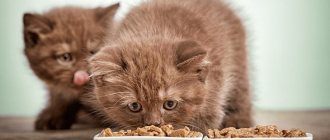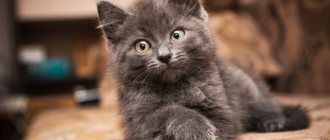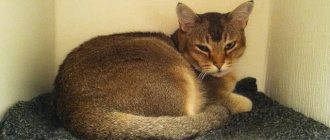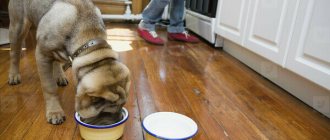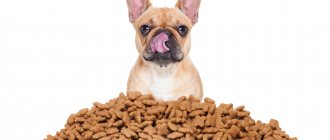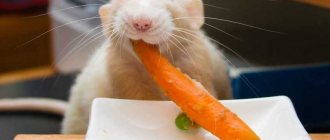There is nothing more nutritious and beneficial for a child’s body than mother’s milk. Despite this fact, some circumstances oblige the owner to look for alternative feeding methods. He has to find out on his own what and how many times he can feed a kitten at 1 month, so as not to harm the baby. By following the rules for introducing complementary foods and excluding prohibited foods, you can easily raise a healthy and strong pet on your own.
Features of feeding a one-month-old kitten
The diet of a 1-month-old kitten depends on the presence of a mother cat. The longer they live together, the later complementary foods are introduced.
If there is a mother cat
On average, breastfeeding continues until two or even three months of age, which makes caring for the baby very easy. Colostrum secreted in the first days after birth is of particular value. Together with it, newborns receive passive immunity, protecting against infections until the first vaccination.
In addition to feeding, the mother cat takes care of the comfortable digestion of her cubs. To do this, she rubs her paws on their tummies after each meal or licks them. This massage makes it easier to go to the toilet, preventing constipation.
If the baby is taken away from his mother
You should not separate the baby from its mother until 1.5 months. If the mustachioed nurse does not have milk, died, or you simply picked up a tiny animal right on the street, try to find him a “foster mother.” This option is the most reliable, but rarely implemented.
If you couldn’t find a new nurse, then you will have to feed your one-month-old baby yourself. Special milk formulas (Gimpet, Beaphar, Royal) from veterinary pharmacies and pet stores will help with this. Their composition is as close as possible to mother's cat milk, so kittens quickly learn to drink directly from a bowl. It is better to give newborns a drink from a pipette, syringe or bottle with a nipple.
Cow's and goat's milk are only suitable as an emergency option before purchasing formula. They do not contain the necessary nutrients, and their constant consumption is fraught with intestinal upset.
Breed differences
The nutrition of a 1 month old kitten practically does not depend on the breed. At this age, he needs a high-calorie diet rich in calcium. It promotes proper growth and the formation of a strong skeleton.
The differences can be seen a little later, after 1.5-2 months:
- British
. Frequent consumption of carrots, kelp and liver changes the blue color. The daily menu should consist of 65% meat products and 25% vegetables. High protein content is essential for these stocky cats, who are characterized by rapid growth and weight gain.
- Scottish folds
. A high-calorie diet has a beneficial effect on the quality of the fur coat. Due to the innate tendency to allergies and urolithiasis, avoid purchasing economy-class food.
- Sphinxes
. Representatives of hairless breeds are characterized by increased appetite and poor intelligibility. They often suffer from obesity and gastrointestinal problems. It is better to feed them strictly by the hour, never exceeding the recommended norms.
Owners of purebred animals should pay attention to ready-made industrial feed. Many manufacturers offer specialized lines focused on the characteristics of specific breeds.
How to teach a one-month-old kitten to eat on its own?
So we touched on one of the main issues regarding the care of a one-month-old kitten - how and when you need to teach it to eat on its own and the time it will take to complete this procedure. Typically, a kitten begins to show interest in the saucer at three weeks of age. At this time, he is more interested in the process of eating food by adult animals than in the food itself.
But in any case, three weeks of age is the best period to start teaching a kitten to eat on its own.
You should start with milk. To do this, you need to pour milk into the cat's saucer, then dip your finger in it and let the baby lick it. The cub will quickly understand that this is a very tasty treat and will reach for the bowl. After this, the kitten can already poke its muzzle into the milk, but the main thing is not to overdo it, otherwise the baby may get scared or choke. After the kitten licks its face several times, you can try to give it freedom of movement. Most likely, the pet will reach for the saucer itself and after a short hitch, nature will take its toll and he will begin to lap. If the attempt is unsuccessful the first time, the procedure should be repeated.
At first, the baby may snort and even sneeze - this is normal, because he is just learning. The kitten can also get carried away and climb its paws right into the cup; such moments need to be stopped and the animal returned to a normal position for eating. To do this, remove the baby's limbs from the saucer and wipe them. If the situation repeats, hold the animal, letting it know that this cannot be done. Then such incidents will stop.
Be attentive and patient with your little animal, and within a few days the kitten will begin to eat on its own. In general, age is not of fundamental importance in this matter; the most important thing here is to show patience and diligence. When the kitten begins to feed itself, do not rush to stuff it with raw meat and potatoes. After all, a kitten’s nutrition from 1 to 3 months should be planned taking into account its unformed body, and for better results it is better to give the pet the opportunity to gradually learn about food other than milk.
Rules for introducing complementary foods
The little pet begins to be fed from 4-8 weeks, gradually diluting the milk menu with more solid products. When introducing complementary foods, follow these rules:
- Puree your meals and focus on carbohydrates and calcium. Cook milk porridges and use a limited amount of meat until baby teeth erupt.
- Add new dishes at intervals of 2-3 days to track the body's reaction. This will help identify allergies and food intolerances.
- Offer to try unfamiliar food straight from your finger. After approval, it can be poured or transferred to a bowl.
- Consider your pet's tastes. If the cat refuses the food offered, you should not force feed it. Thanks to the variety of possible options, the diet can be chosen to suit every taste.
- Avoid food that is too hot or cold. Temperatures above and below room temperature can injure mucous membranes.
- Don't leave uneaten food for later. To avoid indigestion and poisoning, serve only fresh food.
- Try to eliminate sources of noise while eating. Without being distracted by irritants, the baby will focus more on food and quickly learn to eat on his own.
- Avoid overfeeding. Not all babies feel full. It is safer to feed them often, but in small portions.
You can determine the time of introducing complementary foods in the presence of a mother cat by changing her behavior. By 4-6 weeks after birth, her milk supply decreases, so she increasingly leaves the “nest”. With the developed maternal instinct, the pet begins to take the cubs to the kitchen, showing them bowls of food. By repeating after their mother, babies quickly learn to eat on their own.
Natural solid food
A one-month-old kitten does not have enough milk or formula for normal growth and development.
If you plan to feed him natural food in the future , then the following products are added to the diet:
- Beef , poultry meat . First they boil it, then finely chop it or grate it. If the kitten refuses to chew, they start with meat puree for children: smear it on the palate, then put it in a saucer. Gradually add chopped meat and gradually replace it with puree.
- Liquid porridge made from ground oatmeal . The “dish” is prepared without sugar and salt.
- Low-fat cottage cheese . Before use, soften or strain through a strainer and dilute with milk. It is useful to use children's homogenized cottage cheese, it contains all the microelements necessary for the formation of the skeleton.
- Vegetables . Carrots, zucchini, broccoli are boiled and chopped, served with broth or as a puree. Ground meat is added to the dish.
- Eggs . Doctors recommend raw quail eggs; cats cannot digest boiled ones.
- Lean fish . They are given only boiled in small pieces.
- Unsalted cheese . Before use, grind on a grater.
- Fresh grass . It is bought in specialized stores or grown on a windowsill from cereal seeds and placed in an accessible place.
From the first day of complementary feeding, it is important to ensure that the kitten has clean water available around the clock. It is poured into a separate container and changed three times a day. Breeders advise placing 2–3 bowls around the apartment in suitable places, and not using plastic utensils.
Feeding adult cats
Feeding a kitten aged 1 month
Feeding a kitten at the age of 2 months
What foods to give your baby
Proper and balanced nutrition eliminates stunting and other developmental problems. The owner will have to decide in advance what his kittens will eat at 1 month. Mixing “natural” and “drying” negatively affects digestion, causing coprostasis, gastroenteritis and other complications. For your pet’s health, you need to choose only one type of feeding and stick to it for the rest of your life.
Natural food
Feeding “natural” food is much more difficult than dry food. In addition to daily cooking, you will have to take care of purchasing vitamins, since it is almost impossible to reach the norm with food alone. You can feed your little pet:
- boiled quail or chicken yolk;
- minced meat and broth;
- semolina or rice porridge;
- vegetable puree from cabbage, zucchini and pumpkin;
- low-fat kefir, cottage cheese and yogurt.
As an alternative food, you can choose wet and dry food. Any brands of at least premium class, designed for cats under 1 year of age, are allowed.
Wet food
Until the teeth appear, you will have to limit yourself to canned pates. Later you can switch to meat pieces in jelly. These feeds are almost 80% water. They require much less liquid to digest than dry kibble.
Don't pack too big in hopes of saving money. Opened food quickly becomes unusable, so the cat may not have time to eat it before the expiration date.
Dry food
Dry food is good for preventing tartar and is enriched with all necessary vitamins. In addition to the class, you need to pay attention to the manufacturer. Veterinarians do not recommend frequent changes of brands and try not to go beyond a certain brand, even with a therapeutic diet.
At first, it is better to soak the granules in warm water. In this case, even a toothless pet can eat them. When choosing dry food, it is especially important to comply with the water consumption rate. Calculate how much liquid your pet drinks per day and adjust the amount if necessary.
Do I need to continue formula feeding?
Use formulas until the baby is two months old, until he gets used to solid food and begins to eat on his own. After all baby teeth appear, adjust the diet in favor of an adult.
Diet of a one-month-old kitten
Are you wondering what to feed a 1 month old kitten? In this situation, the list of products will be quite limited. The fact is that a fluffy's jaws are not yet designed to chew large pieces of food, and the gastrointestinal tract is not able to digest many foods.
To the question of what kittens can eat, I will answer a little lower. Now let's talk about what types of pet feeding there are. Today, all breeders distinguish two categories:
- use of natural food;
- feeding with food.
I can’t say for sure which of this options is more suitable for your pet. And no one can - the debate about which type of feeding is better has been going on for several years. On the one hand, ready-made food is a properly selected and maximally balanced diet that contains all the necessary microelements. Now you don’t have to worry about what to feed so that the growing body develops harmoniously. On the other hand, there are a large number of supporters of natural food for one-month-old kittens who are confident that they can control the animal’s diet.
Any of these options (with the correct selection of products or food) is not harmful to the purr. The main thing is not to mix canned food and boiled meat. Month-old kittens are still quite small, so their diet is not as rich as that of adult cats. However, even here there is room for diversity. Veterinarians recommend starting feeding your pets with:
- goat milk;
- low-fat cottage cheese, which is a source of calcium;
- boiled chicken yolk, which is pre-mixed with milk;
- porridge cooked in milk or meat broth;
- boiled or steamed vegetables;
- soups (without spices);
- lean boiled meat (which must first be beaten in a blender).
In order to be sure that the baby’s body receives all the substances necessary for harmonious development, you can buy additional supplements. Such vitamin complexes are sold at any veterinary store and are selected depending on the age and nutrition of the purring dog.
What to feed a kitten that does not eat natural food? Try to choose high-quality ready-made food. Under no circumstances take the cheapest products that contain flavor enhancers, dyes and flavors. The most popular cat food brands are Royal Canin and Almo Nature.
Remember that no matter what type of food you choose, the kitten must be provided with open access to clean drinking water. If the fluffy eats food, the need for regular water consumption increases significantly. Change the bowl of water daily and be sure to rinse it with warm water or scald it with boiling water.
Forbidden food
Do not forget that any food from the human table is contraindicated for pets. Stop any attempts by compassionate relatives to feed your “unlucky” pet pickles, sweets, herbs, smoked meats, flour, fried and fatty foods. A moment's pleasure can turn into a long and expensive treatment.
In addition to the foods listed, avoid feeding:
- pearl barley and millet;
- sorrel, onion and garlic;
- any bones;
- pork;
- mushrooms and potatoes;
- raisins and grapes;
- legumes
Don't believe the myths about the benefits of milk and fish. After a year, cats develop lactose intolerance, accompanied by diarrhea and increased gas production. Fish is fraught with the development of urolithiasis and kidney inflammation, so it is also better to avoid its frequent consumption.
Getting your kitten used to solid food
With the appearance of baby teeth, you can diversify your diet with solid foods. Instead of minced meat, offer your pet finely chopped meat and fish pieces. Use only low-fat varieties, not forgetting about pre-freezing and cooking. Two-stage treatment at different temperatures will eliminate infection by parasites.
Gradually reduce the amount of liquid in porridges by adding meat to them. The baby quickly gets used to this additive in broths and cereals, but you will have to tinker with the individual serving of meat. If the pieces remain in the bowl, then try grinding them into minced meat and offering them again. Having become accustomed to the smell and taste, the cat will begin to eat meat in larger quantities.
Solid foods at 1 month
For proper digestion, the kitten needs to eat solid food per month, but you should start introducing it into your daily diet very carefully. It is best to start feeding with some type of cereal, for example with semolina, diluting it as thinly as possible. At the next stage, you can try boiling chicken eggs, but feeding a 1-month-old kitten with protein is not recommended, so you can only give it the yolk and no more than 2 times a week.
After the baby has started eating the yolk, you can start feeding fish and meat in small portions.
As for fish, it is better to give it no more than once a week and try to choose non-fatty varieties, avoid smoked and salted delicacies, they should not be fed to a kitten per month. The most important thing when introducing solid foods is the drinking regime.
Feeding frequency and portion size
When feeding “dry”, it is enough to focus on the norms indicated on the packaging. By weighing your pet, you can easily find out its daily portion.
The frequency of feeding depends only on age, so it is the same for pets with different types of nutrition. The recommended number of meals and portion sizes on natural food can be found in the table.
| Age | Feeding frequency (once a day) | Daily serving size |
| Up to 2 weeks | 10, including night time | 30 ml per 100 g weight |
| 2-3 weeks | 9, including night time | 40-45 ml per 100 g weight |
| 3-4 weeks | 8, including night time | 50-55 ml per 100 g weight |
| 1-2 months | 7 | 120 g |
| 2-3 months | 6 | 150 g |
From three months of age, the portion size is increased to 200 g per 1 kg of weight, and the number of meals is reduced to 5. From this moment until six months, the animal enters the most active growth phase. At this time, veterinarians recommend taking into account the individual characteristics of the pets and monitoring their well-being by checking their indicators in the clinic. If you deviate from the norm typical for your pet's breed, you may need to increase or reduce the usual portions.
If you are often away from work, make sure that your friends, relatives or neighbors feed the kitten. Eating too infrequently can lead to overeating or exhaustion. After six months, your pet can be safely switched to three meals a day, and closer to a year - to two meals a day.
Details
Basic Rules
We present the basic rules, following which you can figure out how to raise and feed a 1-month-old kitten without a cat at home:
1. Food for a one-month-old kitten should have a liquid consistency. Solid inclusions and pieces should be avoided. The kitten will hardly be able to digest such food. 2. When feeding a small kitten for up to a month, use various feeding devices. Bottles with rubber nipples can serve as such devices. 3. Each new product is introduced into the diet gradually and in small portions. 4. Do not overfeed your baby. Control the amount of food in the bowl. 5. Introduce new foods into the kitten’s diet not immediately, but gradually. Give each new product every 3-4 days.
IMPORTANT: Provide the kitten with clean drinking water in the required quantity.
How to train a one-month-old kitten to eat on its own
The kitten begins to show interest in adult food at the age of 3 weeks.
He watches with interest how other animals eat. Complementary feeding should begin with dairy products. Pour milk into a saucer, dip your finger in it and let the kitten lick it. The baby will understand that it’s delicious and will reach for the cup himself.
Then you can poke the kitten's muzzle into the milk, but be careful not to choke. In any case, give the kitten freedom of movement and freedom of choice. He himself will reach for a cup of milk and start lapping it up. Don't think that you will succeed the first time. Be patient and repeat the procedure again. It is normal for the kitten to snort and sneeze.
A baby kitten can get its paws right into the bowl. To wean your kitten from such a bad habit, wipe its wet paws every time.
Hold him by the neck so he doesn't go all the way into the bowl. Be patient with your little pet and after a few days the kitten will learn to eat on its own. The owner of a kitten is always conflicted about whether it is better to feed the kitten dry food or natural food.
Cat breeders debate the benefits all the time. Ready-made cat food is a balanced product. The manufacturer adds everything you need to it: vitamins, healthy additives and microelements. From the point of view of veterinarians, dry food is worthy food for an animal.
Cautions
But with any approach, you need to recall important features:
- If you start feeding your kitten natural products, do not add dry food to its food. The fact is that the process of digesting dry food and natural food is different. Therefore, if you do not want your animals to encounter problems such as gastroenteritis and gastrointestinal colic, then do not feed natural food and dry food at the same time.
- You should not feed your kitten with industrial food of different brands at the same time, this will either lead to an excess of some vitamins or to vitamin deficiency. Digestive problems are also possible.
- Don’t skimp on your pet’s health, buy proper and high-quality food. The kitten should be fed with a product of the “Premium” and “Superpremium” classes.
If you decide to feed your kitten natural food, then adhere to the following rules:
- Diet variety. If from an early age an animal gets used to one type of food, then in the course of its life it will hardly be possible to accustom it to another. Offer your kitten a variety of foods.
- You should not feed your kitten food from your table. Human food contains salt and spices that are harmful to cats.
So what should you feed a one-month-old kitten, besides milk?
You can give complementary foods in the form of cottage cheese. Stir cottage cheese with milk until it reaches a consistency similar to sour cream. The next product that you will introduce into the diet of a month-old kitten is chicken yolk, but it should also be mixed with milk. Porridge with meat and milk broths, soups with broth without spices, and boiled vegetables are good for a kitten.
You can use different products, the main thing is that they are not greasy and are well chopped. Kittens should not be given meat from fatty animals, such as pork, goose, and duck. Add organ meats to your food. Meat should not be given to a kitten raw; it must be boiled first. Fish should not be given to cats often. Frequent consumption of fish leads to kidney disease. For castrated animals, fish is excluded from the diet altogether.
The food of a small kitten should be close to natural. Food should be warm and natural. Do not feed foods that are too hot or very cold. Make sure that the kitten always has clean water.
Feeding regimen or how many times should a kitten be fed 1 month old:
1. Kittens up to two weeks old are fed at least 7 times a day. All feedings are divided into equal time intervals. 2. Kittens aged from 2 weeks to 1 month are allowed to eat 6 times a day. 3. A kitten older than 1 month should receive food 6 times a day in small portions.
A single serving of food for a one-month-old kitten is 30 ml per 100 g of weight. A kitten over 1 month of age is given 50 ml per 100 g of food weight at a time.
The need for vitamins and supplements
Vitamins and minerals are an important part of a balanced diet. You can't go to extremes here. An excess of these elements is no less dangerous than their shortage.
Owners who feed their pets “natural” often face the problem of hypo- and hypervitaminosis. By relying on calcium and fish oil, they often overdo it and forget about other important nutritional elements. It is very difficult to reach the recommended amount of vitamins and minerals without the help of a veterinarian, so it is better to immediately seek help from a veterinary clinic. After the examination, the doctor will be able to adjust the existing diet and select the drug complexes necessary specifically for your pet.
When dry feeding, it is enough not to skimp on the quality of the feed. All the necessary elements are already included in the composition, so deviations can only indicate the presence of pathology.
A balanced diet, observed from early childhood, will provide your pet with strong immunity for the rest of its life. Avoid prohibited foods, do not mix different types of food, and be sure to consult a veterinarian with any questions that arise. Remember that every body is different, so some recommendations may not be suitable for it.
The article is for informational purposes only. Contact your veterinarian!
What to feed a one-month-old kitten?
This is a question that worries many. So, you brought your soft baby into your home. Emotions are overwhelming, he seems small and defenseless. For him, you become real parents. It is you who is responsible for the correct diet, education, and litter box training.
Feeding a one-month-old kitten is a complex process. Don’t think that you will get by with store-bought food - you will simply kill the animal. The best food for a kitten at this age is cat's milk. But if it happens that she is not around, then you will have to feed the fluffy yourself.
You can find another nursing cat: the animals accept foundlings well and feed them as if they were their own kittens. If this option is not possible, the first thing to do is contact an experienced veterinarian so that he describes in detail the diet and nutrition.
